American model and actress Suzy Parker (1932–2003) was known in the 1950s as the most photographed woman in the world and is now considered as the very first Supermodel. The red-headed beauty defined glamour in the 1950s and in 1956, at the height of her modelling career, became the first model to earn $100,000 per year. During the late 1950s and early 1960s, Parker also became the glamorous star of several Hollywood productions.
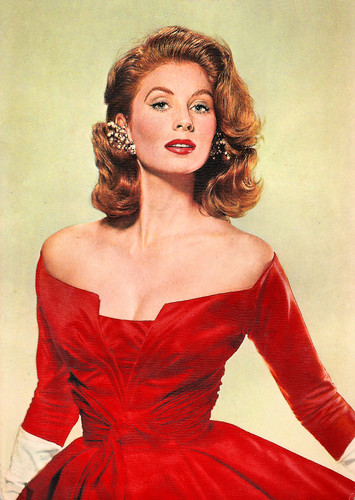
Italian postcard by Rotalfoto, Milano, no. 89.
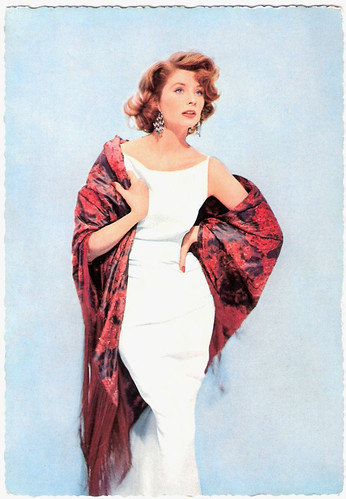
German postcard by Krüger, no. 902/10. Photo: Terb Agency.
In 1932, Suzy Parker was born Cecilia Ann Renee Parker in Long Island City, New York, to George and Elizabeth Parker. George disliked the name Cecilia and called her Susie, a name which Parker would retain throughout her life. A French Vogue photographer later changed the spelling to Suzy.
Parker's family moved to Highland Park, New Jersey, and then to Florida. When Parker was 15, sister Dorian (a.k.a. Leigh Parker), herself one of the top models of the era, introduced her to Eileen Ford. In the period just after World War II, models were becoming celebrities and Suzy would become even more famous than Dorian.
A photo of the 15-year-old appeared that year in Life magazine and one of her first magazine advertisements was for DeRosa Jewelry. While still in high school in Jacksonville, Fla., she modelled in the summers for Ford Models, and after graduation went to work full time for the agency. Although she still lived with her parents in Florida, she stayed in New York City with Dorian when she had modelling assignments there.
Dorian introduced Parker to her fashion-photographer friends, Irving Penn, Horst P. Horst, John Rawlings, and a young Richard Avedon. Parker became Avedon's muse and the so-called signature face of the Coco Chanel brand. Along with other models like Dovima and Lisa Fonssagrives, Parker signified a postwar world of stylish promise for all. She was the first model to earn $200 per hour and $100,000 per year (ca. 900,000 today). Vogue declared her one of the faces of the confident, post-war American woman.
She worked non-stop for labels as Revlon, Hertz, Westinghouse, Max Factor, Bliss, DuPont, Simplicity, Smirnoff, and Ronson shavers. Parker also was on the covers of about 70 magazines around the world, including Vogue, Elle, Life, Look, and Paris Match. In the mid-1950s she abandoned being a cover girl for a few years to be a photographer herself, apprenticing with Henri Cartier-Bresson in Paris and working for the French edition of Vogue.
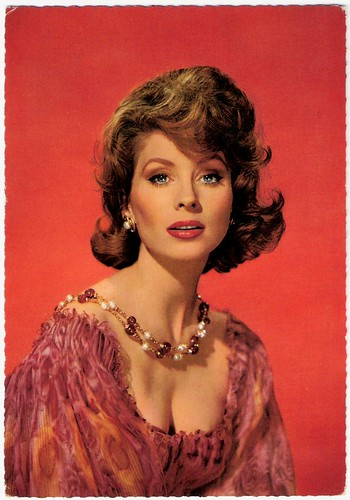
German postcard by Krüger, nr. 902/78.

Italian postcard by Rotalfoto, Milano, no. N 131.
Suzy Parker's next step was a Hollywood career. Photographer Richard Avedon recommended her for a fashionable cameo in Funny Face (Stanley Donen, 1957), starring Audrey Hepburn and Fred Astaire.
Douglas Martin in the New York Times: "Parker's trademark in photographs and later on the movie screen was icy sophistication, often likened to that of Grace Kelly, but in person she exuded a girl-next-door prettiness and a sort of wacky loquaciousness. Audrey Hepburn's role in Funny Face, as a fast-talking beatnik who somewhat unwillingly becomes a world-famous model, was inspired by her".
Suzy herself was on screen for just two minutes in a musical number described as 'Think Pink number'. But director Stanley Donen then gave her a leading role in his comedy Kiss Them for Me (Stanley Donen, 1957), opposite Cary Grant and Jayne Mansfield. However, the film was a disappointment and Parker's acting got negative reviews.
Parker got better reviews for her next appearances in the dramas Ten North Frederick (Philip Dunne, 1958) with Gary Cooper, and The Best of Everything (Jean Negulesco, 1959). During the shooting of the British war film A Circle of Deception (Jack Lee, 1960), she met future husband Bradford Dillman. Her later films include Flight from Ashiya (Michael Anderson, 1964) with Yul Brynner, and Chamber of Horrors (Hy Averback, 1966).
She also played dramatic roles in TV shows such as Burke's Law (1963) plus appearances as herself on a number of quiz shows such as I've Got a Secret. Her most famous television appearance was in a 1963 episode of Twilight Zone in which she played six different parts. Parker's last role was in a 1970 episode of Night Gallery.
She did, in a way, make one other film 'appearance' in The Beatles' documentary film Let It Be (Michael Lindsay-Hogg, 1970), in which the band performed their song Suzy Parker. The song, one of the few credited as written by all four Beatles, was part of their Academy Award-winning score for the original songs they performed in the film.
Suzy Parker was married three times. In 1950, she married her high-school sweetheart, Ronald Staton, and divorced him in 1953. In 1955, Parker married French journalist Pierre de la Salle with whom she had a daughter, Georgia. They divorced in 1961. In 1963 she became Suzy Parker Dillman after marrying Bradfor Dillman.
After a car accident in 1964, Parker mostly retired from modelling and focused on her family. She had three more children with Bradford Dillman: daughter Dinah (born 1965) and sons Charlie (1967) and Christopher (1969). The family lived in Bel Air, Los Angeles, until Dinah was bitten by a rattlesnake in the yard and almost died. They then moved to Montecito in the Santa Barbara area, where Suzy Parker remained until her death in 2003. She was 69.
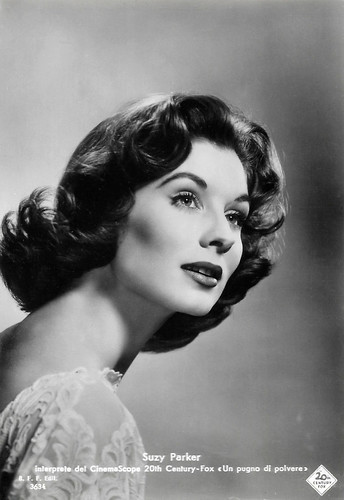
Italian postcard by B.F.F. Edit. (Ballerini & Fratini, Firenze), no. 3634. Photo: 20th Century Fox. Publicity still for Ten North Frederick (Philip Dunne, 1958).
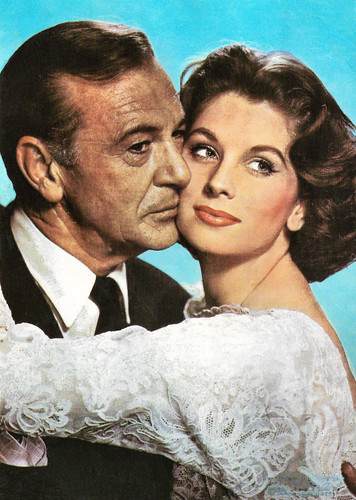
Romanian postcard by Casa Filmului ACIN. Photo: publicity still for Ten North Frederick (Philip Dunne, 1958) with Gary Cooper.
Sources: Douglas Martin (New York Times), Wikipedia and IMDb.

Italian postcard by Rotalfoto, Milano, no. 89.

German postcard by Krüger, no. 902/10. Photo: Terb Agency.
The signature face of Chanel
In 1932, Suzy Parker was born Cecilia Ann Renee Parker in Long Island City, New York, to George and Elizabeth Parker. George disliked the name Cecilia and called her Susie, a name which Parker would retain throughout her life. A French Vogue photographer later changed the spelling to Suzy.
Parker's family moved to Highland Park, New Jersey, and then to Florida. When Parker was 15, sister Dorian (a.k.a. Leigh Parker), herself one of the top models of the era, introduced her to Eileen Ford. In the period just after World War II, models were becoming celebrities and Suzy would become even more famous than Dorian.
A photo of the 15-year-old appeared that year in Life magazine and one of her first magazine advertisements was for DeRosa Jewelry. While still in high school in Jacksonville, Fla., she modelled in the summers for Ford Models, and after graduation went to work full time for the agency. Although she still lived with her parents in Florida, she stayed in New York City with Dorian when she had modelling assignments there.
Dorian introduced Parker to her fashion-photographer friends, Irving Penn, Horst P. Horst, John Rawlings, and a young Richard Avedon. Parker became Avedon's muse and the so-called signature face of the Coco Chanel brand. Along with other models like Dovima and Lisa Fonssagrives, Parker signified a postwar world of stylish promise for all. She was the first model to earn $200 per hour and $100,000 per year (ca. 900,000 today). Vogue declared her one of the faces of the confident, post-war American woman.
She worked non-stop for labels as Revlon, Hertz, Westinghouse, Max Factor, Bliss, DuPont, Simplicity, Smirnoff, and Ronson shavers. Parker also was on the covers of about 70 magazines around the world, including Vogue, Elle, Life, Look, and Paris Match. In the mid-1950s she abandoned being a cover girl for a few years to be a photographer herself, apprenticing with Henri Cartier-Bresson in Paris and working for the French edition of Vogue.

German postcard by Krüger, nr. 902/78.

Italian postcard by Rotalfoto, Milano, no. N 131.
Icy sophistication as trademark
Suzy Parker's next step was a Hollywood career. Photographer Richard Avedon recommended her for a fashionable cameo in Funny Face (Stanley Donen, 1957), starring Audrey Hepburn and Fred Astaire.
Douglas Martin in the New York Times: "Parker's trademark in photographs and later on the movie screen was icy sophistication, often likened to that of Grace Kelly, but in person she exuded a girl-next-door prettiness and a sort of wacky loquaciousness. Audrey Hepburn's role in Funny Face, as a fast-talking beatnik who somewhat unwillingly becomes a world-famous model, was inspired by her".
Suzy herself was on screen for just two minutes in a musical number described as 'Think Pink number'. But director Stanley Donen then gave her a leading role in his comedy Kiss Them for Me (Stanley Donen, 1957), opposite Cary Grant and Jayne Mansfield. However, the film was a disappointment and Parker's acting got negative reviews.
Parker got better reviews for her next appearances in the dramas Ten North Frederick (Philip Dunne, 1958) with Gary Cooper, and The Best of Everything (Jean Negulesco, 1959). During the shooting of the British war film A Circle of Deception (Jack Lee, 1960), she met future husband Bradford Dillman. Her later films include Flight from Ashiya (Michael Anderson, 1964) with Yul Brynner, and Chamber of Horrors (Hy Averback, 1966).
She also played dramatic roles in TV shows such as Burke's Law (1963) plus appearances as herself on a number of quiz shows such as I've Got a Secret. Her most famous television appearance was in a 1963 episode of Twilight Zone in which she played six different parts. Parker's last role was in a 1970 episode of Night Gallery.
She did, in a way, make one other film 'appearance' in The Beatles' documentary film Let It Be (Michael Lindsay-Hogg, 1970), in which the band performed their song Suzy Parker. The song, one of the few credited as written by all four Beatles, was part of their Academy Award-winning score for the original songs they performed in the film.
Suzy Parker was married three times. In 1950, she married her high-school sweetheart, Ronald Staton, and divorced him in 1953. In 1955, Parker married French journalist Pierre de la Salle with whom she had a daughter, Georgia. They divorced in 1961. In 1963 she became Suzy Parker Dillman after marrying Bradfor Dillman.
After a car accident in 1964, Parker mostly retired from modelling and focused on her family. She had three more children with Bradford Dillman: daughter Dinah (born 1965) and sons Charlie (1967) and Christopher (1969). The family lived in Bel Air, Los Angeles, until Dinah was bitten by a rattlesnake in the yard and almost died. They then moved to Montecito in the Santa Barbara area, where Suzy Parker remained until her death in 2003. She was 69.

Italian postcard by B.F.F. Edit. (Ballerini & Fratini, Firenze), no. 3634. Photo: 20th Century Fox. Publicity still for Ten North Frederick (Philip Dunne, 1958).

Romanian postcard by Casa Filmului ACIN. Photo: publicity still for Ten North Frederick (Philip Dunne, 1958) with Gary Cooper.
Sources: Douglas Martin (New York Times), Wikipedia and IMDb.
No comments:
Post a Comment